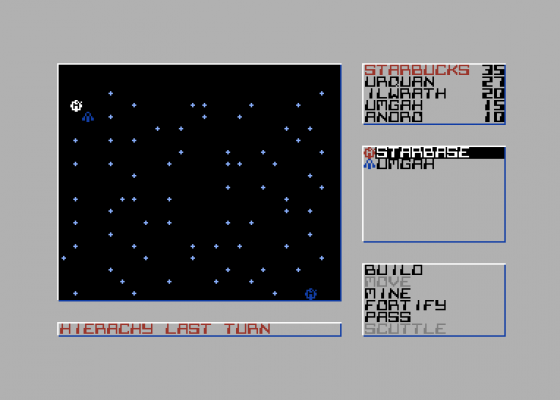
Future Publishing
 1st March 1991
1st March 1991
Categories: Review: Software
Publisher: Accolade
Machine: Commodore 64/128
Published in Commodore Format #6
Star Control (Accolade)
Accolade's Star Control is a space colonisation and conquest strategy game, with arcade style moments thrown in for good measure whenever there's a direct confrontation between ships of the Hierarchy (boo) and the Alliance (hurrah). Each side starts with only one space station and must build ships, explore nearby worlds, mine them for income, fortify them for defence, colonise them because otherwise the colonists would have nothing to do and eventually undo all the hard work the other side has gone to by blowing it to pieces. In other words, two sides wage war against each other.
When ships from both sides meet, the game leaves the stellar map screen used, for the most part, to display the course of the imaginary conflict and moves on to a four-way wrap-around screen which forms the arena for the forthcoming space battle. Each side can build ships with different capabilities and weapons so early battles are difficult to win but only one ship per side ever meets in a given battle. The space ships have left and right steering functions, along with thrust. They have inertia. This means that, if you move a ship in one direction, the only way to stop is to turn it around and apply thrust in the opposite direction. Accurate flying, especially when your opponent is carrying out evasive manoeuvres is nothing if not tricky but it brings some tactical skill into the game.
Complicating matters only slightly is a rather unconventional Zoom feature. That is, when two ships come close enough to each other, the size of the sprites representing the vessels increases twofold. The view zooms back out the instant the range between the ships increases again.

While the arcade subgame runs, both sides can examine their ships' status by way of crew and energy bars displayed on a panel at the bottom of the screen. The ships expend energy not just while manoeuvring but while firing weapons. When a ship is hit, its crew is eventually depleted. This ultimately determines which ship wins a dogfight. Though the conditions you have to meet in order to come out the winner are varied, ploughing your way through your opponent's interstellar empire can be a real slog. Ships move slowly from star system to star system. If one of those systems has been fortified by the enemy, you need to get two ships through it to overcome the defences.
Knowing which ships to send into battle against specific opponents is the kind of knowledge you gain by experience.
The strategic element is predictably visually unappealing but the arcade head-to-head bashes are fine. It would have been nice to have a slightly larger star map though. It only takes up around a third of the screen and it's fiddly. Stars change colour once you've explored them, indicating what kinds of worlds have been discovered, but the size of the display means these details are really hard to make out.
The readouts and settings are much clearer. What's more, the host of in-game options give the game extra depth. For instance, control of either side can be given over to the computer to a lesser or greater degree (this is unusual - normally you have a choice of human or computer opponent and that's it). The quality of equipment used by each side can be made better or worse than the other and there are practice modes to help you get used to the different kinds of vessel you can build.
Star Control's main faults: only one player can use a joystick and the manual fails to convey essential information clearly (and apart from that, most of it is fairly naff science fiction). It's by no means a mainstream game and that may put off more people than it attracts. Star Control makes a challenging strategy bash for those who fancy a long lonely slog but it's not the final frontier.
Bad Points
- Two players, but only one joystick.
- Only one real strategy to master, no surprise moves on the part of the computer opponent.
- Documentation is way off the mark.
Good Points
- Long games (helped by a save option) provide value for money.
- Remarkable range of game options including practice mode.
- Special weapons on different ships help you think up special tactics.
- Issuing orders is easy.
- Zoom facility is unusual but makes the combat sections more exciting.
- Well matched computer opponent to play against.











